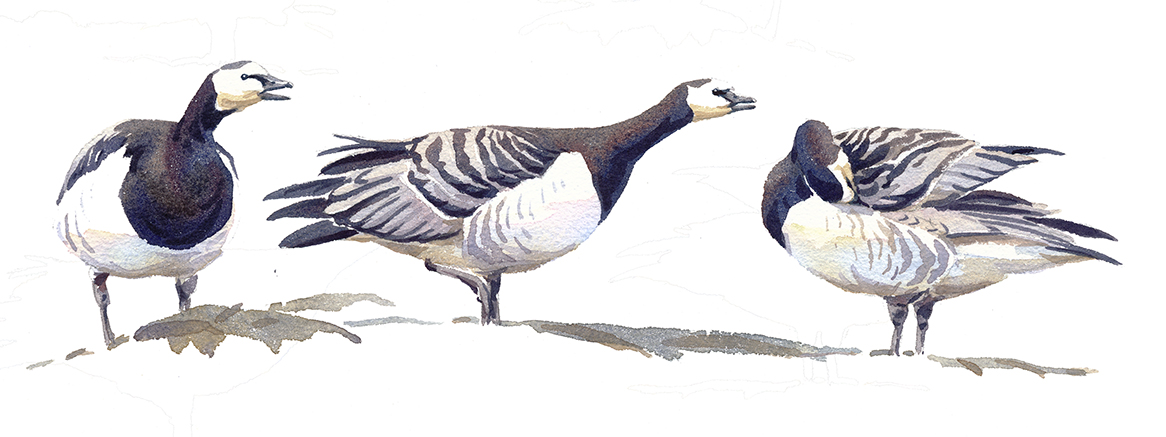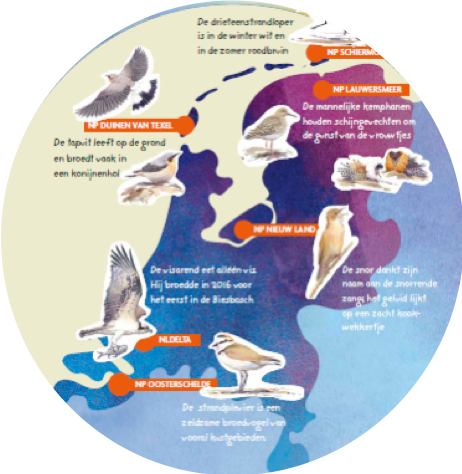
Bird migration
Bird migration is perhaps one of the most fascinating natural phenomena. Every year billions of birds cross the earth from their wintering areas to their breeding grounds. And back again. Almost all these birds prefer flying over land. Above the open sea they find nothing to eat, but on the border of water and land there’s a lot of food for many avian species. Precisely along this border of water and land six Dutch National Parks are located: Schiermonnikoog, Lauwersmeer, Duinen van Texel, Nieuw Land, Oosterschelde and NLDelta.
Migration routes along the coast
The most important migration routes are concentrated along the coasts of the continents. The Netherlands lie exactly on an important intersection on the East-Atlantic Flyway. Every year tens of millions of birds of about three hundred species pass through the Netherlands. Due to its strategic location our country is frequented by immense numbers of birds. National Park Schiermonnikoog and the Wadden Sea are natural parts of this important junction for migratory birds.
National Park Schiermonnikoog
Schiermonnikoog is an ideal place to experience bird migration. Above the mudflats you can observe the ‘ballet’ of large flocks of wading birds. In the bushes in the dunes, large numbers of fieldfares and redwings eat all the berries before continuing their travels. A lot of migratory birds breed in the National Park and in the winter season a lot of feathered winter guests stay on the island. Scientists are well aware that Schiermonnikoog is full of migratory birds; a lot of scientific research is done on the island.
A few examples of migratory birds on Schiermonnikoog
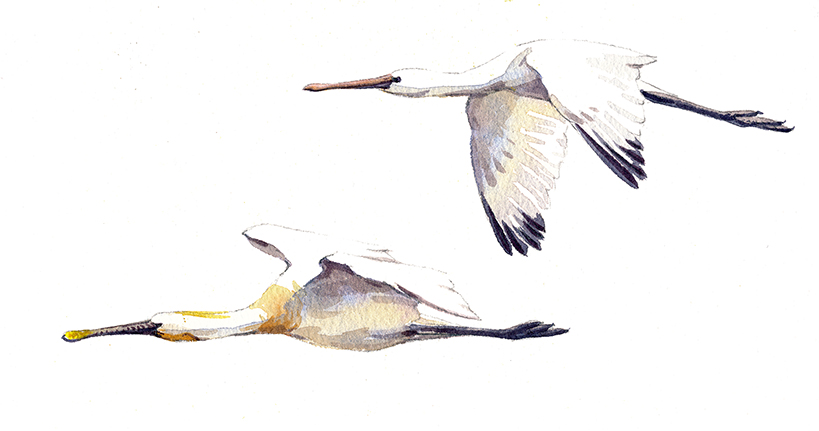
The spoonbill
Many spoonbills spend the winter in Mauretania, on the west coast of Africa, in an area that has a lot in common with the mudflats of the Wadden Sea. Young spoonbills always hang around for another year or so before starting their own families. Only when they are two years old, they return to the Netherlands. Here you can read all updates about the spoonbills of Schiermonnikoog.

The sanderling
On the beach you can observe sanderlings running after the outgoing waves. They eat small creatures that are left behind on the sand by the sea. That’s why they walk where a wave just has been. Sanderlings breed far north, in Greenland and Siberia. Some sanderlings spend their winter in the Netherlands. Other sanderlings fly much further, some of them as far as South-Africa. Here you can experience the seasons as if you were a sanderling.

The barnacle goose
Barnacle geese are true winter guests. They breed in Siberia and spend the winter in the Netherlands. Not until halfway May do they return to their breeding areas. If they would leave earlier, they would arrive in the snow.
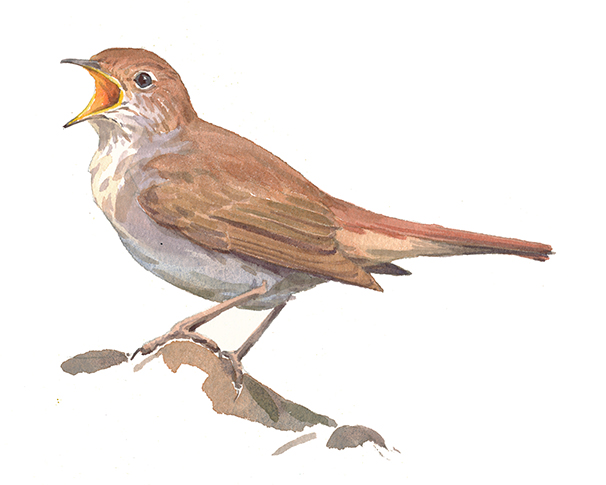
The nightingale
The nightingale is especially known for its singing. It can make a lot of different sounds, and it can, for such a small bird, make quite a lot of noise. It sings not only during daytime, like most singing birds do, but continues to do so in the night. That’s what its name comes from. Nightingales breed in the dunes. They are very difficult to spot, because most of the time they hide in the bushes. After summer they fly to Africa and spend the winter there.
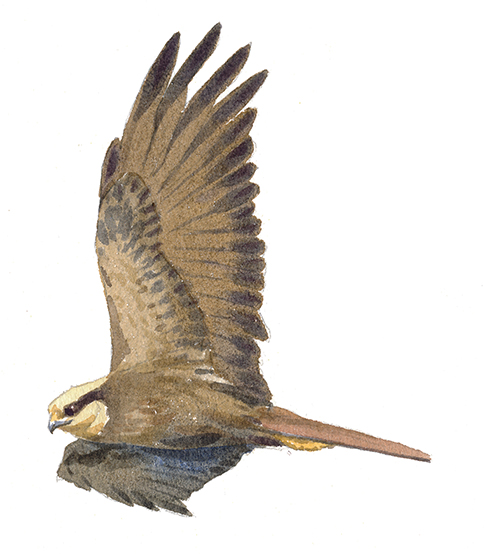
The marsh harrier
The marsh harrier is an elegant bird of prey that sometimes performs spectacular airborne acrobatics. In spring the male drops a freshly caught rabbit in full flight, which the female then catches from the air. In summer father and mother harrier use this method to teach their young how to hunt. Marsh harriers that breed in the Netherlands spend their winters in Africa, south of the Sahara. Marsh harriers that breed in Sweden winter in the same area, but they never meet each other on the road. The Swedish marsh harriers fly along the east side of the Pyrenees; the Dutch marsh harriers take the western route.
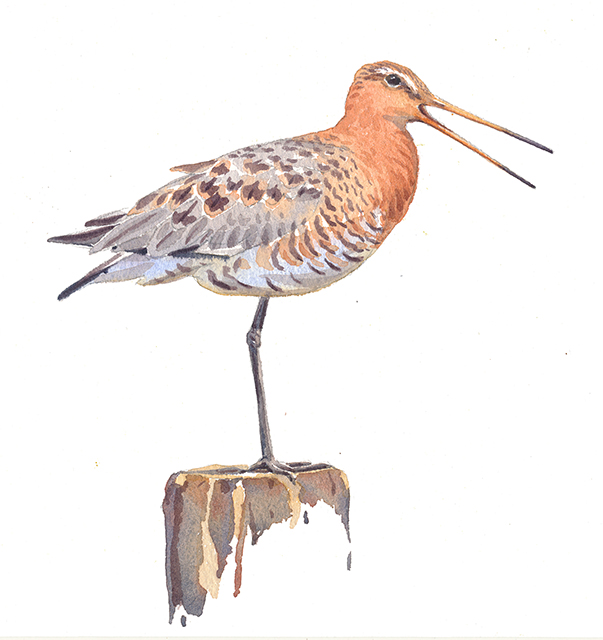
The black-tailed godwit
Godwits prefer eating insects, which they pick from the ground or pull out of the soil with their long bills. In the tip of their bill, they have a very sensitive sensory organ, so they hunt gropingly! Young godwits are nidifugous, which means that they start walking around as soon as they have hatched and have to catch their own insects for food. On their way to the south godwits become omnivorous and start eating rice, berries, and shellfish as well. They spend their winter in Africa. Black-tailed godwits are among the first migratory birds that return in early spring. Halfway February you can hear the first godwit make its characteristic noise.
copyright illustrations: Erik van Ommen
Tips for watching (migratory) birds
- The marina (jachthaven) and the causeway to the ferry (veerdam) are good spots for watching wading birds. When you arrive during incoming tide, the birds come closer and closer.
- From the viewing huts at the Westerplas you have an unobstructed view of the large numbers of spoonbills that breed around the Westerplas. In winter these are good spots for watching widgeons, pintails, and other water birds.
- In the Banck’s polder you can find migratory birds like black-tailed godwits, barnacle geese, brent geese and golden plovers.
- In spring everywhere in the dunes you can hear nightingales singing.
- In autumn, the bushes in the dunes are full of members from the thrush’s family. Use your ears to find them, because they are very good at hiding in the bushes.
Migratory bird route
Following our ‘trekvogelroute’ is a pleasant way to make a tour along the different migratory birds’ hotspots on Schiermonnikoog. You can find the description on the website of Natuurmonumenten. This itinerary contains not only route instructions, but also information about the spots you visit and the birds you can see there. (NB Only available in Dutch.)
Excursions with migratory birds
- Bird walk with migratory birds
- Nightingale walk
- Breeding bird excursion
Free bird migration poster
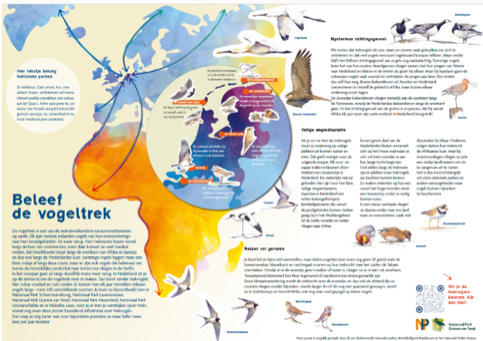
The six National Parks along the Dutch coast have teamed up to visualize this extraordinary wealth in the Netherlands: a bird migration poster for all ages. This free poster is not only a gem on your wall, but also offers an overview of the international bird migration routes and introduces eleven iconic migratory birds that visit the Netherlands every year. Would you like to have one of these free posters? Come to information centre Het Baken and get one. Hurry, because our supply is limited!

